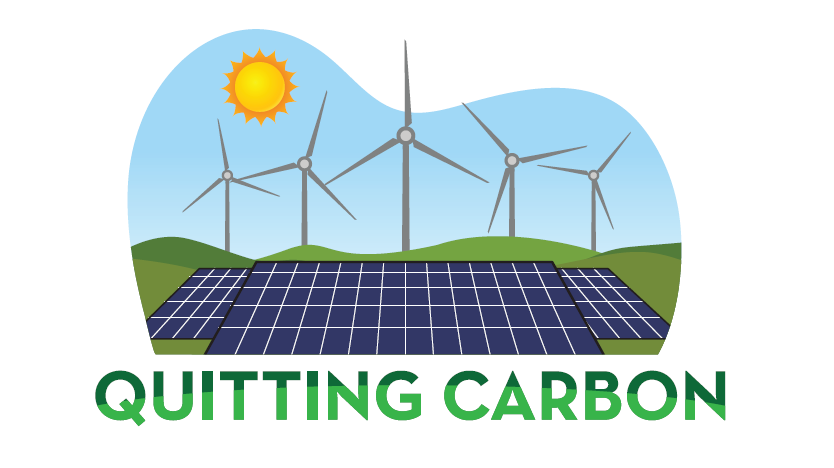What I’m reading: Offshore wind proves its worth, the global solar boom, New York fast-tracks renewables, and more

Quitting Carbon is a 100% subscriber-funded publication. To support my work, please consider becoming a paid subscriber or making a one-time donation.
Welcome back to another recap of highlights from what I’ve been reading. Have a great weekend. And thanks, as ever, for reading.
The U.S.’ first offshore wind farm proves its worth, too
I wrote last week about a report from Danish energy giant Ørsted documenting how its South Fork Wind project off the coast of Long Island, New York, is already providing benefits to ratepayers and to the grid in the Northeast.
According to a dispatch published by the New York Times’ Catrin Einhorn from Block Island, Rhode Island, the nation’s first offshore wind farm is similarly proving its worth, delivering cheaper and more reliable power, blissful quiet, and even high-speed internet to the island.
The 30-megawatt Block Island Wind Farm was the nation’s first offshore wind farm when it came online in 2016. The project was built off the coast of Block Island by a company called Deepwater Wind, which was later acquired by Ørsted.
"The benefits have been extraordinary," Keith Stover, head of the Block Island Town Council, told Einhorn.
Einhorn recounts how the offshore wind farm has improved life on the island:
"Before the five turbines started spinning a few miles off the coast, this island ran on five big generators. Soot-spewing and earsplitting, the machines burned a million gallons of diesel a year, ferried in from the mainland on tanker trucks and stored underground. Energy costs, tied to the volatile oil market, seesawed so much that local businesses struggled to manage their budgets, residents said. Power surges and dips fried household appliances. Clocks wouldn’t keep time. Those who lived near the power company described scraping soot off their windows and having to wash their curtains every month."
"Then, at 5:30 a.m. on May 1, 2017, with the offshore turbines up and running, the island’s utility company turned off the generators. As the motors whirred down, a new sound could be heard, bright and strangely loud in the sudden quiet: birdsong."
Another offshore wind conference canceled
I mentioned in my last roundup that the American Clean Power Association had just canceled its flagship offshore wind conference, which had been scheduled for next week in Boston, Massachusetts.
In another sign of the headwinds facing the industry, the University of Maine canceled its annual conference focused on the emerging floating offshore wind sector, Maine Public Radio reported earlier this week.
University spokesperson Samantha Warren said the American Floating Offshore Wind Technical Summit (AFloat) was cancelled "in recognition of changing federal policies and priorities." In April, the Trump administration suspended a $12.5 million grant for the university's floating offshore wind program.
Five hundred experts from around the world attended the two-day conference in Portland last year.
Plunging costs unlock new applications for solar
Cheap panels mean that solar isn’t just for rooftops or open fields any longer. With the cost of panels plunging by more than 90% since 2010, it now makes economic sense to install solar over irrigation canals, on a balcony, and even as a wind break between rows of crops.
I’ve written in previous roundups about the emergence of so-called "balcony" solar in the U.S. after the market took off in Germany. Utah was a trendsetter among the states in passing legislation enabling the installation of these small solar systems in the U.S. The Beehive State could soon be joined in that effort by two New England states.
"Small solar-panel kits that can be assembled as easily as an Ikea bookcase and plugged into a regular residential outlet could be coming soon to New Hampshire and Vermont," Sarah Shemkus reported last month for Canary Media. "Lawmakers and advocates in both states are preparing legislation that would make these plug-in solar systems accessible to residents who don’t have the space, money, or inclination to install a larger, conventional rooftop array."
If you want to learn more about a startup looking to break into the small modular solar space, read my recent conversation with Raya Power co-founder Meghan Wood.
We’re also discovering how beneficial the double harvest of crops and solar power can be for farmers.
"Imagine a field where solar panels and crops coexist – with no trade-off. It sounds like science fiction, but that's precisely what researchers from Aarhus University have now documented in a full-scale agrivoltaic pilot project in the Danish countryside," according to Aarhus University’s Jesper Bruun Petersen.
"Our measurements show that wheat and grass-clover mixtures grow just as well between vertical solar panels as in open fields. At the same time, the panels produce electricity in a daily pattern that better matches energy demand. It's a win-win," said Marta Victoria, lead author of a study on the pilot project published in the journal Energy Nexus and associate professor at the Department of Mechanical and Production Engineering, Aarhus University.
"Even with some shade, the yield per square meter is almost the same. The crops don't seem to mind the presence of solar panels and they like the wind protection that they provide," said study co-author Uffe Jørgensen, professor from the Department of Agroecology, Aarhus University.
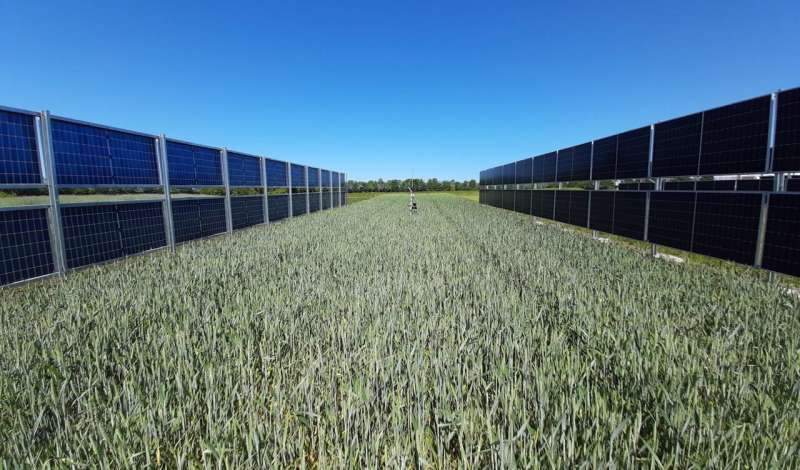
The solar boom extends well beyond China
China, Texas, and even Pakistan have all recently had a spotlight shone on their booming solar markets. But new research from energy think tank Ember shows that the solar boom is a global phenomenon.
"Global solar installations are on track for another record year," wrote the authors of a report the organization published last month. "In the first six months of 2025, the world added 380 GW of new solar capacity – 64% higher than during the same period in 2024, when 232 GW were installed."
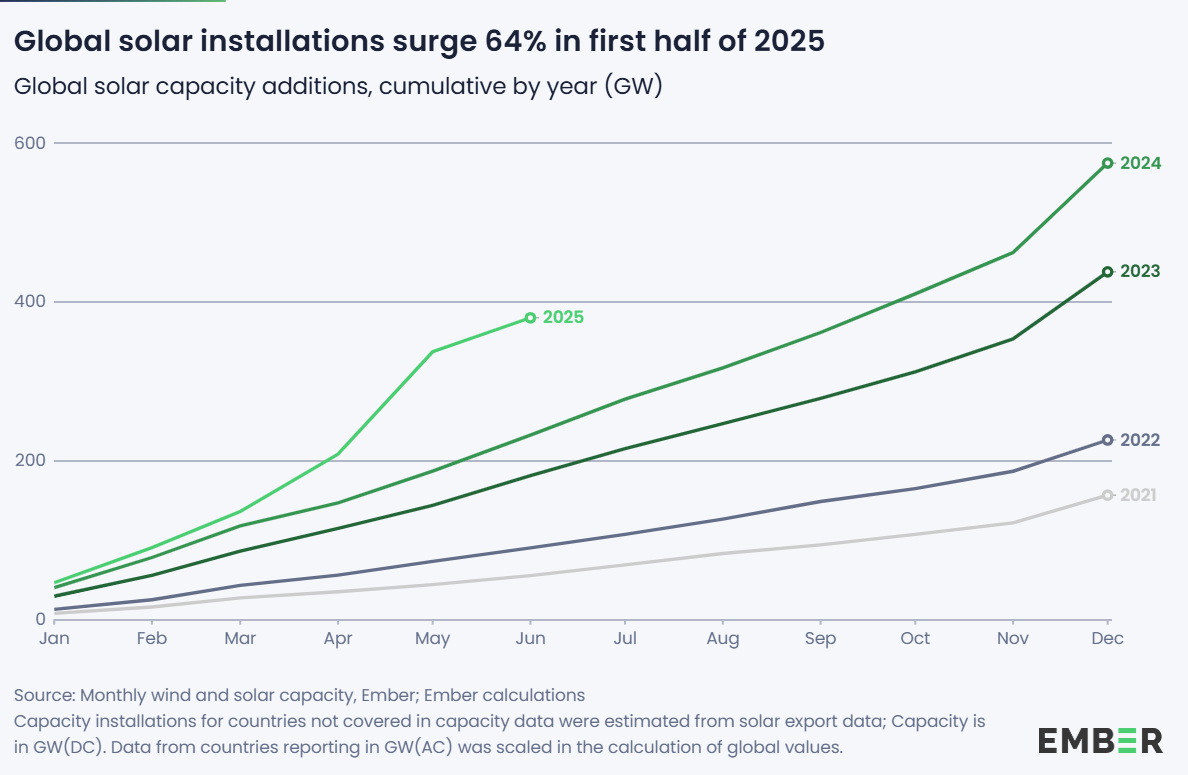
Another, perhaps unexpected, booming solar market? Brazil.
Distributed solar is the fastest-growing power source in the country, according to the U.S. Energy Information Administration (EIA).
"Distributed solar generation capacity grew from less than 1 gigawatt (GW) in 2018 to 40 GW in 2025 through June, accounting for 43% of all electricity capacity additions over that period," finds an EIA analysis published last week.
"In 2012, Brazil implemented net metering policies, which have recently contributed to large increases in distributed solar generation capacity. … As of June 30, 2025, total solar electric generating capacity in Brazil was 23% of the total electric generating capacity."
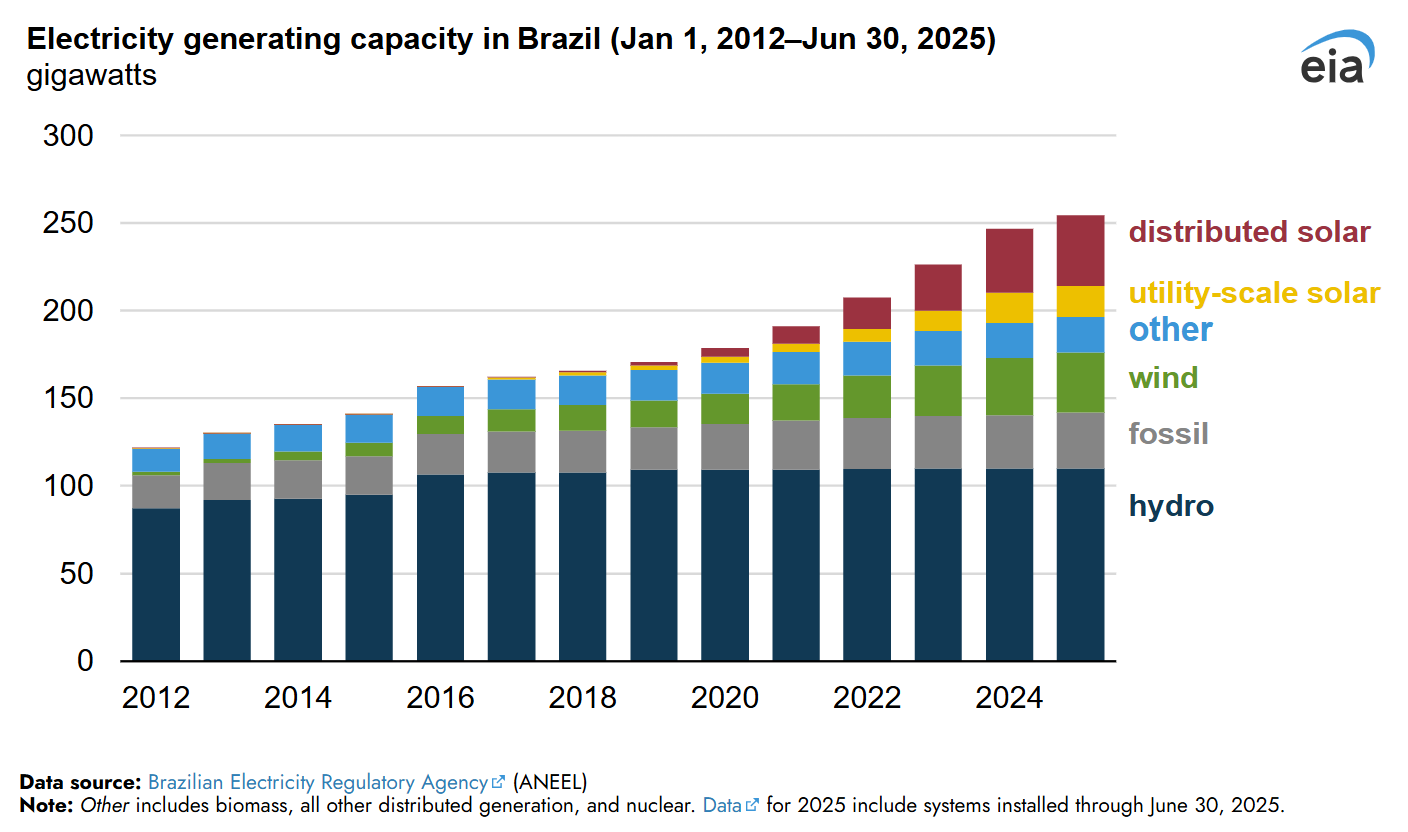
SOO Green is greenlit
It looks like the SOO Green HVDC Link might finally have secured the last approval it needs to begin construction.
"SOO Green — a 2.1-GW transmission project that would link the PJM Interconnection and the Midcontinent Independent System Operator — has secured all the rights to its route by gaining a final municipal franchise agreement in Iowa, moving the project a step closer to construction," Utility Dive’s Ethan Howland reported last week.
"The merchant transmission project aims to deliver a mix of wind and solar, smoothed out with energy storage, from Iowa to Illinois via a 525-kV high-voltage, direct current line that would run about 350 miles underground inside railroad rights of way," he added.
That last detail is what really intrigued me when I last reported on the project.
SOO Green has been gestating for so long that I published a Q&A with an executive from the project for Energy Monitor more than four years ago! Long-distance interstate HVDC transmission projects like SOO Green can often take a decade or longer to complete in the U.S.
Despite SOO Green’s protracted gestation, I’m still convinced that building long-distance transmission inside interstate highway and railroad rights of way can get the projects built faster.
New York fast-tracks renewables to snag expiring federal tax credits
New York just joined Colorado, California, and Maine in fast-tracking renewables projects so they can quality for federal tax credits under the accelerated expiration timeline enshrined in the Republicans’ One Big Beautiful Bill.
"Recognizing the near-term need for power to meet increasing electricity demand as well as economic development needs and the importance of adapting to shifting federal policies, Governor Hochul is launching a new solicitation for renewable energy and directing state agencies to work together to responsibly advance shovel-ready renewable energy projects as quickly as possible. These efforts are designed to support New York ratepayers by using sunsetting federal clean energy tax credits to bring down costs," according to a September 26 New York State Energy Research and Development Authority (NYSERDA) press release.
According to NYSERDA, the new "solicitation is designed to advance late-stage large-scale renewable energy projects ready to commence construction in New York." Eligibility applications for the Large-Scale Renewables Solicitation are due on October 21 and final proposals are due on December 4.
Heat pumps slash fuel oil use in Maine
In one of my first stories here at Quitting Carbon, published last November, I wrote "forget what you’ve heard, heat pumps can thrive in the cold."
And perhaps the best case study I know of proving that point is the success of the heat pump market in Maine. Gov. Janet Mills (D) has set a goal of installing 275,000 heat pumps statewide by 2027, after an initial goal of 100,000 installations was achieved two years early in July 2023.
For the past decade, public officials in the state have been urging Mainers to swap out fossil fuel-burning boilers and furnaces for electric heat pumps. That effort, backed by state and federal incentives, is working.
"New federal data from U.S. Census Bureau’s American Community Survey show about half of Maine households still use heating oil as their primary source of heat, but that share has fallen nearly 20% since 2018," reported WMTW's Jon Chrisos this week. "At the same time, electricity use for home heating has nearly doubled."
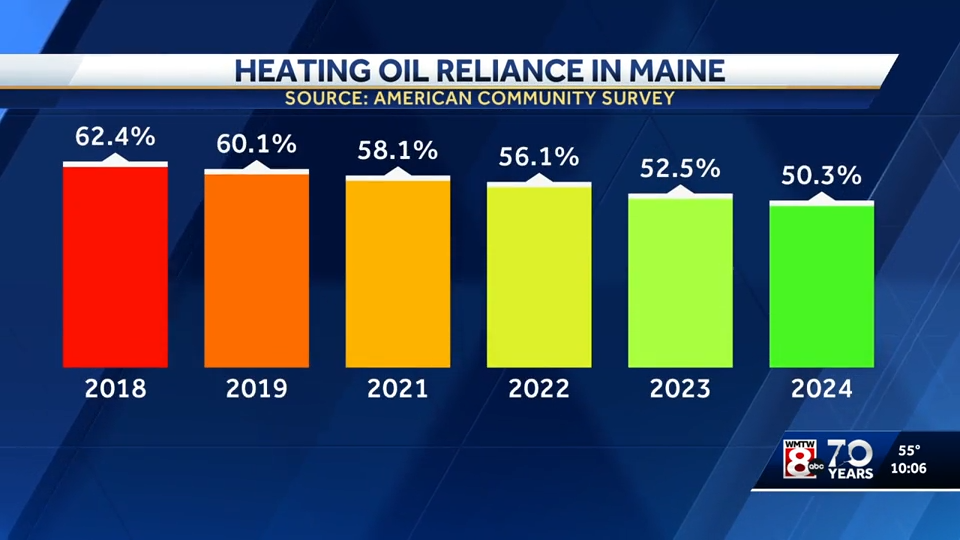
Bonus 1: Inspiration from Uruguay
The Washington Post's Allyson Chiu recently profiled Ramón Méndez Galain, a university professor who become Uruguay's energy secretary and from 2008 to 2015 led the country's push to decarbonize its power grid.
"In the years that Galain served as the country’s top energy official, a period that spanned two administrations, Uruguay installed dozens of renewable energy plants. Within just five years after he took over, the country was able to almost entirely decarbonize its grid, with 98 percent of its energy coming from renewable sources," Chiu writes.
Last month, Galain was recognized for his work with a $4 million award from the San Francisco-based philanthropy Climate Breakthrough.
"His new vision," writes Chiu, "is to see Uruguay’s success story replicated in other countries." To that end, Galain serves as executive director of Ivy, an environmental nonprofit that advises governments across Latin America on how to transform their energy sectors.
Bonus 2: Say no evil
The Trump administration's Department of Energy keeps adding terms to a banned word list.
"The Energy Department has added 'climate change,' 'green' and 'decarbonization' to its growing 'list of words to avoid' at its Office of Energy Efficiency and Renewable Energy," Politico's Zack Colman reported last week.
"In addition to 'climate change' and 'green,' EERE forbid officials from using 'emissions' to avoid the implication that they are a negative," he wrote. "Other terms officials must ditch include 'energy transition,' 'sustainability/sustainable,' 'clean' or 'dirty' energy, 'Carbon/CO2 Footprint' and 'Tax breaks/tax credits/subsidies.'"


